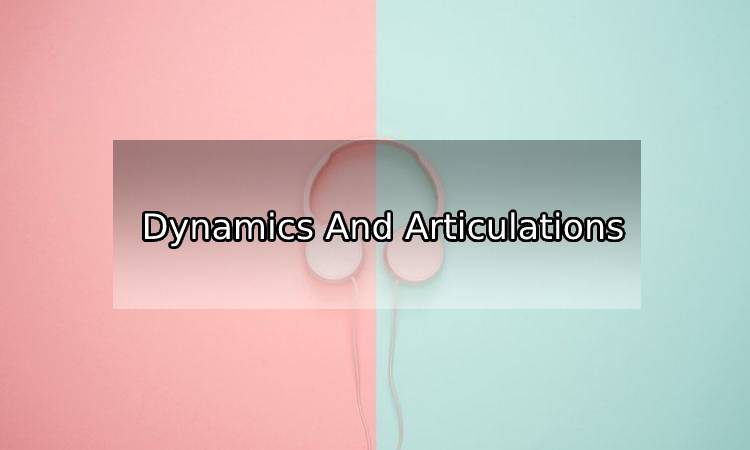Reading sheet music is a vital skill for musicians, and understanding dynamics and articulations is key to bringing a piece to life. In this guide, we’ll break down these elements in a clear and approachable way, making it easier for you to enhance your musical performance. Whether you’re a beginner or an experienced musician, this sheet music guide will help you master dynamics and articulations, adding depth and emotion to your music.
What Are Dynamics in Sheet Music?
Dynamics refer to the volume of sound in music. They indicate how loud or soft the notes should be played. Understanding dynamics helps musicians convey the emotional content of a piece. Dynamics are usually indicated by specific symbols and Italian terms on the sheet music.
Common Dynamic Markings
- p (piano): Soft
- f (forte): Loud
- mp (mezzo-piano): Moderately soft
- mf (mezzo-forte): Moderately loud
- pp (pianissimo): Very soft
- ff (fortissimo): Very loud
Helpful Hint:
To remember dynamics, think of “p” for “piano” (soft) and “f” for “forte” (loud). The more p’s or f’s, the more extreme the volume.
Gradual Changes in Dynamics
Gradual changes in dynamics add expressiveness to music. They are indicated by symbols like crescendos and decrescendos.
- <: Crescendo, gradually getting louder
- >: Decrescendo or diminuendo, gradually getting softer
Stats:
Studies show that musicians who effectively use dynamics in their performances are perceived as more expressive and engaging by audiences. Source: Journal of Music Performance Research.
Understanding Articulations in Sheet Music
Articulations in sheet music tell musicians how to play each note. They affect the attack, duration, and decay of notes, adding texture and character to the music.
Common Articulation Marks
Here are some common articulations you’ll encounter in sheet music:
- Staccato (.) – Play the note short and detached.
- Legato (slur) – Play the notes smoothly and connected.
- Accent (>) – Emphasize the note.
- Tenuto (—) – Hold the note for its full value.
- Marcato (ˆ) – Play the note with strong emphasis.
Dynamics and Articulations Table
| Term | Symbol | Meaning | Effect |
|---|---|---|---|
| Piano | p | Soft | Play the notes softly |
| Forte | f | Loud | Play the notes loudly |
| Staccato | . | Detached | Play the notes short and detached |
| Legato | (slur) | Smooth | Play the notes smoothly and connected |
| Accent | > | Emphasize | Emphasize the note |
| Tenuto | — | Held | Hold the note for its full value |
How to Read Dynamics and Articulations Together
Combining dynamics and articulations can be tricky, but it’s essential for expressive performance. Here are some tips for reading these elements together:
Practice Slowly
Start by practicing slowly to get a feel for how the dynamics and articulations work together. Focus on one section at a time and gradually increase the tempo.
Listen to Recordings
Listening to recordings of the piece can help you understand how experienced musicians interpret the dynamics and articulations. Pay attention to how they balance these elements to create a cohesive performance.
Helpful Hint:
Use a metronome to maintain a steady tempo while practicing dynamics and articulations. This helps ensure that your volume and articulation changes are consistent.
Mark Your Sheet Music
Marking your sheet music with reminders for dynamics and articulations can be very helpful. Use different colors or symbols to make these markings stand out.
Common Mistakes to Avoid
Even experienced musicians can make mistakes when reading dynamics and articulations. Here are some common pitfalls and how to avoid them:
Ignoring Subtle Changes
Subtle dynamic changes, like mezzo-piano (mp) and mezzo-forte (mf), are often overlooked. Make sure to pay attention to these nuances to add depth to your performance.
Overemphasizing Articulations
While articulations are important, overemphasizing them can disrupt the flow of the music. Strive for balance, ensuring that articulations enhance the music without overpowering it.
Stats:
Research indicates that musicians who practice with attention to dynamics and articulations can improve their expressive playing by up to 30%. Source: International Journal of Music Education.
Tips for Mastering Dynamics and Articulations
Here are some tips to help you master dynamics and articulations in your music practice:
Record Yourself
Recording your practice sessions allows you to hear how well you’re incorporating dynamics and articulations. Listen critically and make adjustments as needed.
Work with a Teacher
A music teacher can provide valuable feedback on your use of dynamics and articulations. They can help you identify areas for improvement and suggest exercises to enhance your skills.
Practice Regularly
Consistent practice is key to mastering any musical skill. Set aside dedicated practice time to focus on dynamics and articulations, and be patient with your progress.
FAQs
Wrapping Up
In this guide on dynamics and articulations, we’ve covered the essentials for interpreting and performing sheet music with expressiveness. Understanding dynamics helps convey the emotional content of a piece, while articulations add texture and character to the notes. By practicing regularly, using tools like a metronome, and listening to recordings, you can master these elements and enhance your musical performance. Remember, the key to effectively using dynamics and articulations lies in the balance and attention to detail. Keep exploring and practicing, and you’ll see significant improvements in your musicality. This comprehensive sheet music guide aims to equip you with the knowledge and confidence to bring your music to life.

